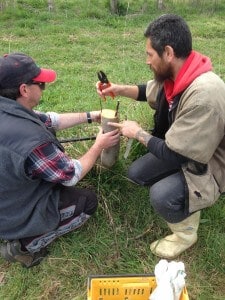There are plenty of winners in a new partnership between EIT and the horticulture industry.
Level three Sustainable Fruit Production students from Hawke’s Bay are being snapped up after a mixed module pre-employment programme that sees them start their studies immersed in the practical side of the industry before heading to the classroom for the theory.
Horticulture tutor Erin Simpson says that having the classroom on an orchard sits very comfortably with his very kinaesthetic learners.
“Industry buy-in is a big one for us with this,” says Erin, who works closely with Work and Income, StudyLink and local iwi to place students.
Such is the success that eight have already been employed fulltime, with more jobs in the wings.
It is the first time such a partnership has been trialled with the horticulture students, and hopes are high it will soon be replicated in the Tairāwhiti region.
John Bostock, of JM Bostock Ltd, is the biggest industry supporter of the programme – and he’s a huge fan.
“We are really motivated to help teenage people into the work force with real prospects of a real job at the end,” says John, whose company is a group of innovative and vertically-integrated companies producing high-value, top quality,
safe and healthy foods that are sent worldwide.
“We do on-site training using our own managers in our own fields, giving students a chance to see them at work.”
JM Bostock also offers 15 hours work a week for the students, allowing them to supplement their income and get real world training.
“We are constantly short of staff but there is a big gap between unemployment rates and people capable of work.”
The 20 week EIT course is run only in the winter months in Hawke’s Bay.
“It really only works then because of the seasonal activities,” says Erin. “We start with pruning, pest and disease control,tractor driving, orchard machinery usage, irrigation and maintenance and then thinning, so it is sequential through the season.”
And once November rolls around there are jobs waiting for suitable candidates.
“The timing is ideal. There are huge shortages of permanent labour here and the industry knows that they need to get
people on board – general workers and supervisors are in demand.”
Erin is working with the team at the Tairāwhiti campus as they put in place a similar programme.
Tairāwhiti rural and trades group manager Steve Phelps says plans are afoot to run the same type of pre-employment
programme in Tairāwhiti in 2014.
“The horticulture industry is a big player in the Gisborne and wider Tairāwhiti region, so we want to be able to help in any way we can and in all manner of training,” says Steve. “Industry buy-in is vital to ensure we are designing programmes that meet their needs and provide solid employment outcomes for students.”

